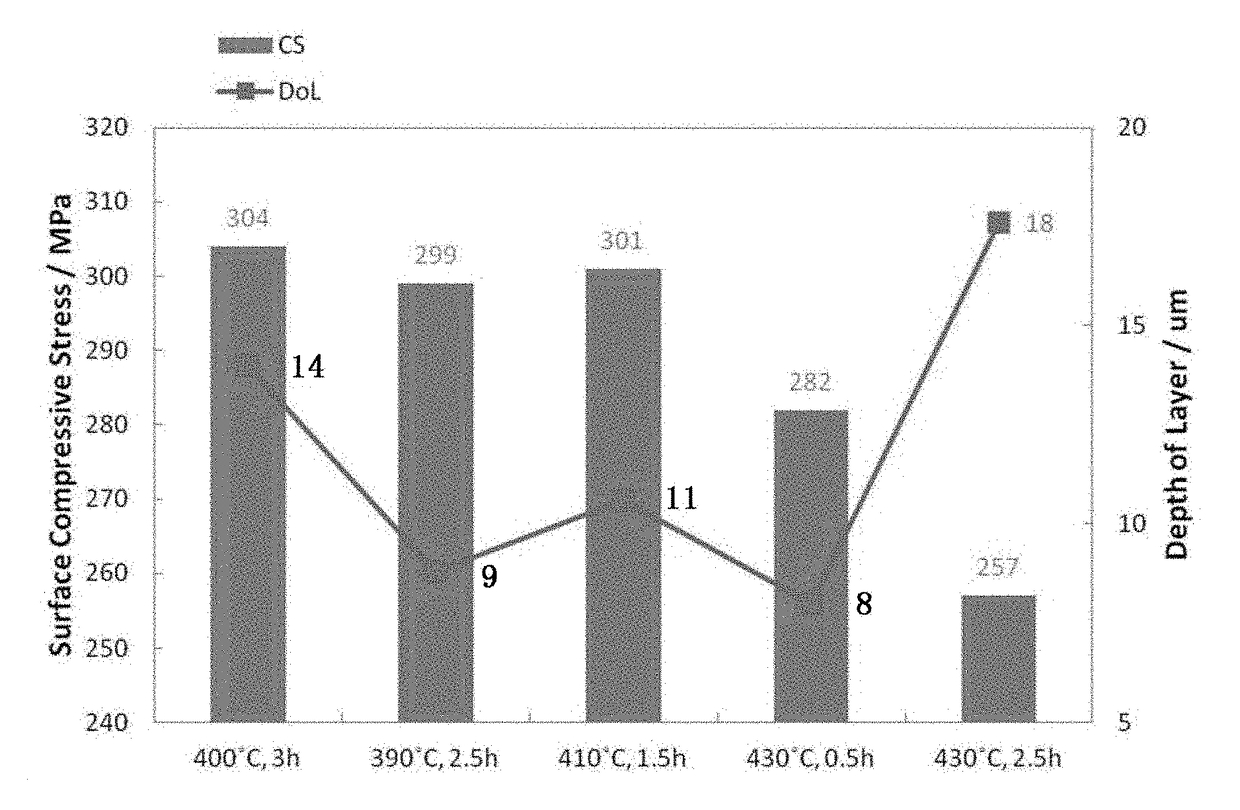Chemically toughened flexible ultrathin glass
a flexible, chemically toughening technology, applied in glass making apparatus, other domestic objects, manufacturing tools, etc., can solve the problems of lack of ductility of glass, difficult production of glass sheets with a thickness less than 0.5 mm, etc., to achieve excellent thermal shock resistance for chemical toughening and practical use, and improve the effect of flexibility
- Summary
- Abstract
- Description
- Claims
- Application Information
AI Technical Summary
Benefits of technology
Problems solved by technology
Method used
Image
Examples
example 1
[0152]The glass having the composition according to Example 1 in Table 1 is heated to melt, made into a glass mother sheet of 440×360×0.2 mm3 via down draw, and then cut with a conventional abrasive cutting wheel with more than 200 diamond teeth. The sample is sized to 100×100×0.2 mm3. A total of 40 samples are prepared. Then 20 samples are chemically toughened in 100% KNO3 for 15 hours at 430° C. The rest of 20 samples are not chemically toughened as the reference. After ion exchange, the toughened samples are cleaned and measured with FSM 6000. The results show that the average CS is 122 MPa, and the DoL is 14 μm.
[0153]The strength of glass is measured by a three-point bending test. In the test the glass sample is horizontally placed on two parallel rigid metal rods, and a loading metal rod is provided above the glass to press downwards the glass until breakage occurs in the glass. The three-point bending result shows that the glass has a bending strength as high as 147 MPa, and c...
example 2
[0155]The glass with the composition according to Example 2 in Table 1 is heated to melt, made into a glass mother sheet of 440 mm×360 mm with a thickness of 0.1 mm via down draw, and then cut with a conventional diamond tip. The sample is sized to 50×50 mm2. A total of 120 samples are prepared. Then 100 samples are chemically toughened in 100% KNO3 under different conditions. The rest of 20 samples are not chemically toughened.
[0156]After toughening, the ion-exchanged glass samples are washed and their CS and DoL are measured with FSM 6000. The CS and DoL are shown in FIG. 1. The mechanical strength of these samples is tested with the three-point bending test. As shown in FIG. 2, the chemically toughened glass has a flexibility increase. The chemically toughened glass also has better Weibull distribution compared with untoughened ones, as shown in FIG. 3. The Weibull distribution shows the sample distribution of toughened glasses and the distribution of untoughened glasses, and it ...
example 3
[0158]The glass with the composition according to Example 8 in Table is heated to melt, made into a glass mother sheet of 440×360×0.3 mm3 via down draw, reduced in thickness by polishing and grinding, and then cut into a size of 250×250×0.3 mm3 by a diamond cutter to test the resistance to temperature difference. After chemical toughening at 400° C. for 3 hours, the samples are heated in the center of the panel to a defined temperature, and the edges are maintained at room temperature. The difference in temperature between the hot center of the panel and the cool panel edge represents the resistance to temperature difference of the glass when the breakage occurs in less than or equal to 5% of the sample. The samples are recorded that all have a resistance to temperature difference of more than 200 K. Before testing, the samples are abraded with sandpaper with a grain size of 40 to simulate extreme damages which is possible in actual use. This proves adequately that the ultrathin gla...
PUM
| Property | Measurement | Unit |
|---|---|---|
| surface compressive stress | aaaaa | aaaaa |
| surface compressive stress | aaaaa | aaaaa |
| surface compressive stress | aaaaa | aaaaa |
Abstract
Description
Claims
Application Information
 Login to View More
Login to View More - R&D
- Intellectual Property
- Life Sciences
- Materials
- Tech Scout
- Unparalleled Data Quality
- Higher Quality Content
- 60% Fewer Hallucinations
Browse by: Latest US Patents, China's latest patents, Technical Efficacy Thesaurus, Application Domain, Technology Topic, Popular Technical Reports.
© 2025 PatSnap. All rights reserved.Legal|Privacy policy|Modern Slavery Act Transparency Statement|Sitemap|About US| Contact US: help@patsnap.com



